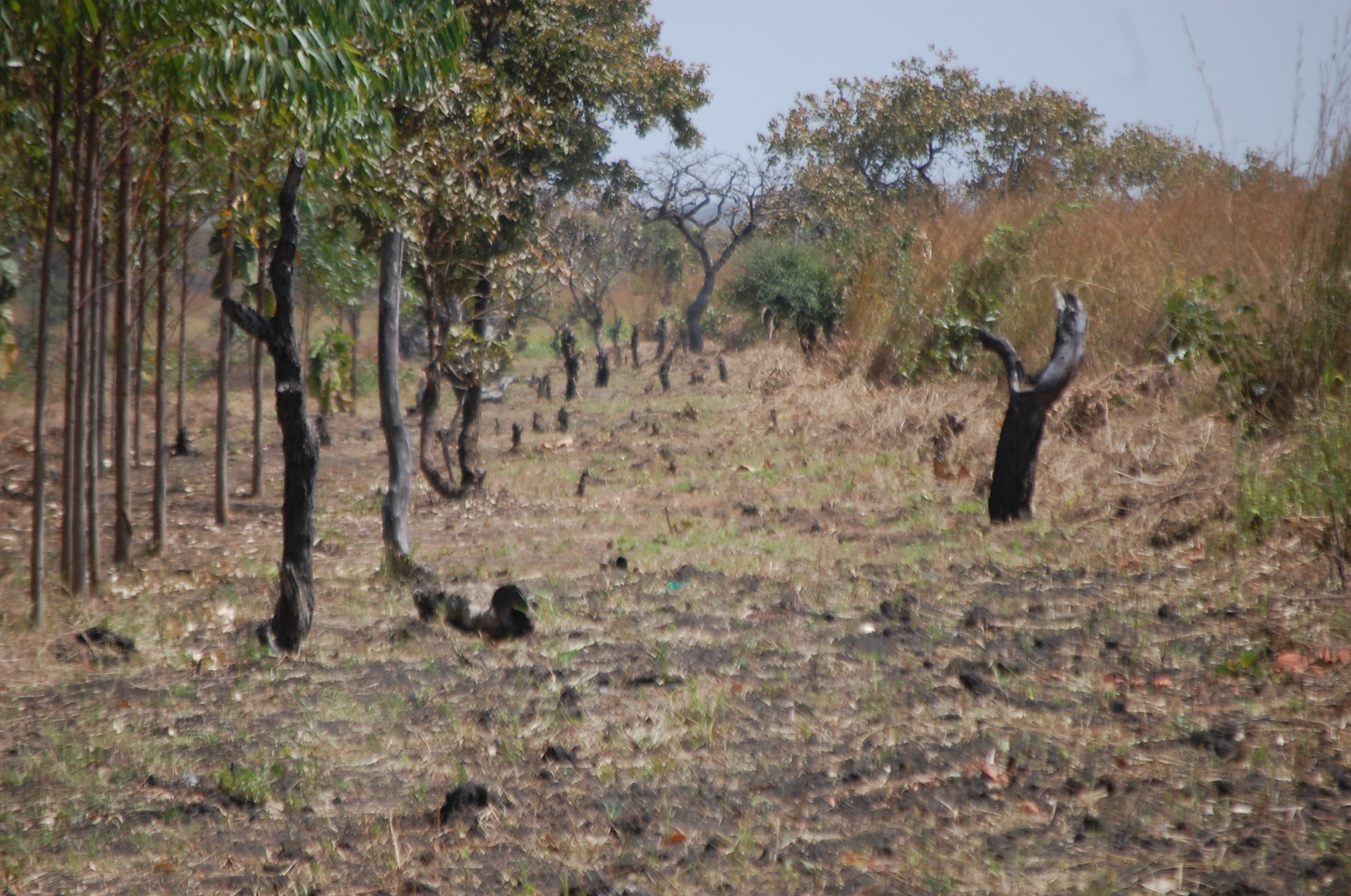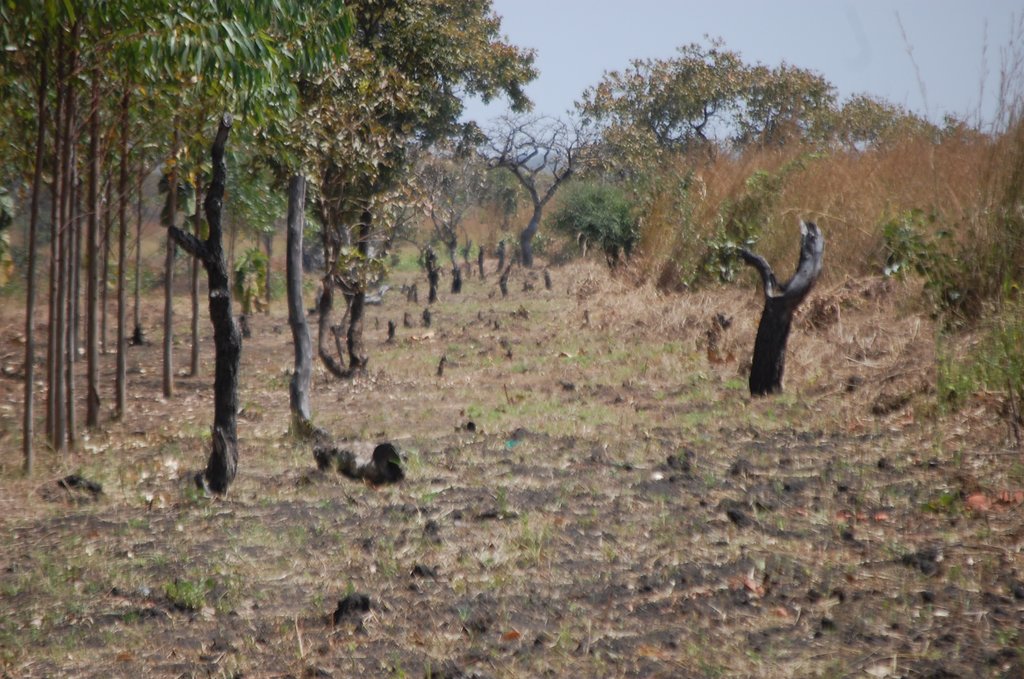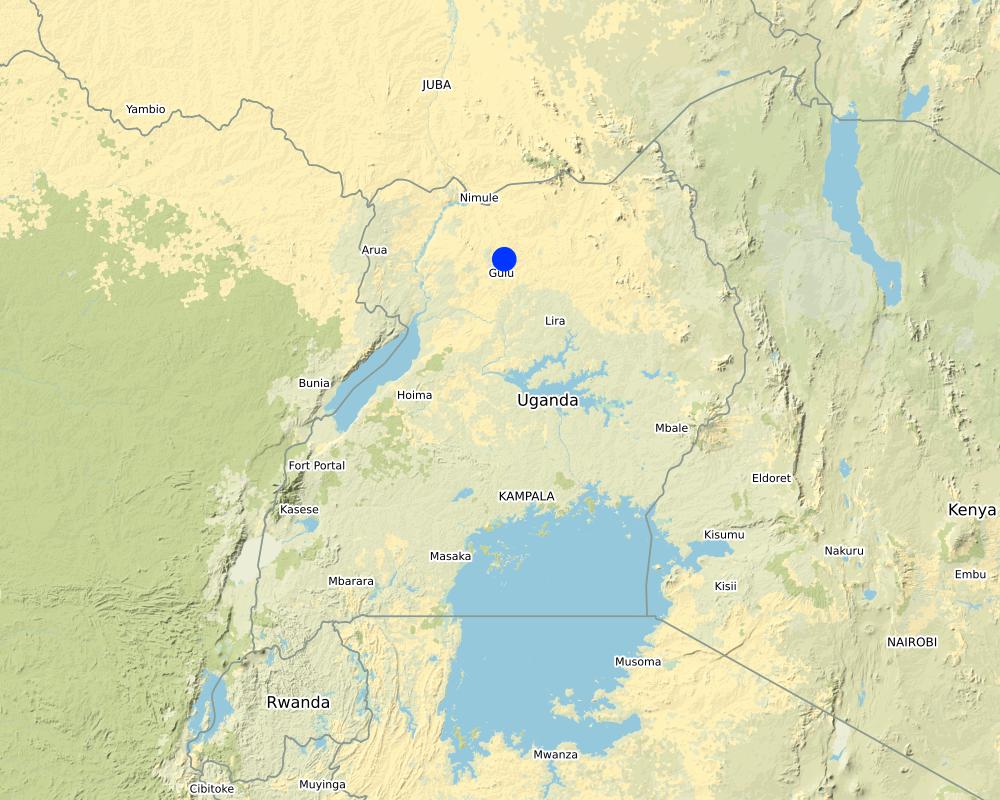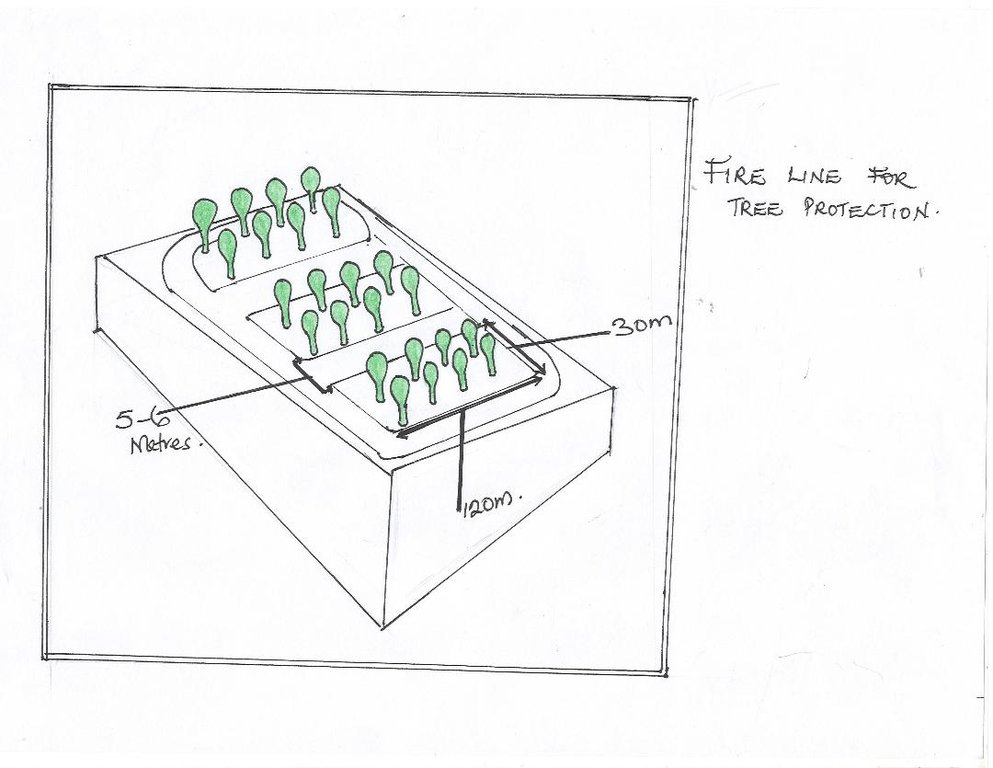Firelines For Tree Protection [Uganda]
- Creation:
- Update:
- Compiler: Kamugisha Rick Nelson
- Editors: JOY TUKAHIRWA, Bernard Fungo
- Reviewers: John Stephen Tenywa, Nicole Harari, Udo Höggel
Koyo
technologies_2149 - Uganda
View sections
Expand all Collapse all1. General information
1.2 Contact details of resource persons and institutions involved in the assessment and documentation of the Technology
Key resource person(s)
SLM specialist:
Anywar Michael
070485161
Gulu tree farmers association
Gulu District
Uganda
Name of project which facilitated the documentation/ evaluation of the Technology (if relevant)
Scaling-up SLM practices by smallholder farmers (IFAD)Name of the institution(s) which facilitated the documentation/ evaluation of the Technology (if relevant)
Uganda Landcare Network (ULN) - Uganda1.3 Conditions regarding the use of data documented through WOCAT
When were the data compiled (in the field)?
27/4/2017
The compiler and key resource person(s) accept the conditions regarding the use of data documented through WOCAT:
Ja
1.4 Declaration on sustainability of the described Technology
Is the Technology described here problematic with regard to land degradation, so that it cannot be declared a sustainable land management technology?
Nee
Comments:
The technology is established during the dry season to guard against spread of fire within a tree or garden plantation for environmental conservation
2. Description of the SLM Technology
2.1 Short description of the Technology
Definition of the Technology:
Fire lines are established at the boundary between tree plantations to guard against wild forest fires that destroy the valuable tree species
2.2 Detailed description of the Technology
Description:
Firelines, also known as firebreaks, are vegetation-free spaces, established within or between tree plantations. They also often serve as roads for motorised transport used to collect forest produce such as firewood and timber. The primary aim of this technology is to prevent wild fires from attacking and destroying trees, especially during the dry seasons. In northern Uganda, the technology is based on firelines of 5-6 meters width. Planted forests that use this technology in northern Uganda have an average size of 30 m by 120 m.
The establishment of this technology requires professional advice, starting with demarcation, using ropes or strings, and tools such as hand hoes, machetes and slashers. Maintenance of fire lines involves monitoring to ensure that the spaces are free of vegetation and dead wood. Sometimes, big trees with large canopies are maintained to discourage vegetation undergrowth's and accumulation of dead materials on forest floors.
The benefits derived from this SLM technology are both short and long term, including protection of valuable tree species from being affected by the fire, reduction of impact of air pollution and promotion of ecological balance. When professionally done, the value of these products can significantly offset the cost of maintaining the firebreaks in a given forest setting, especially where such fires become common. It is important to note that fire lines alone may not be a measure to prevent fire outbreaks. There could be need for community bylaws and fire fighting facilities to supplement this effort.
2.3 Photos of the Technology
2.4 Videos of the Technology
Comments, short description:
Video link for fire line for tree protection in Gulu District
Date:
10/12/2017
Location:
Gulu District, Northern Uganda
Name of videographer:
Issa Aiga
2.5 Country/ region/ locations where the Technology has been applied and which are covered by this assessment
Country:
Uganda
Region/ State/ Province:
Northern Region,Uganda
Further specification of location:
Gulu Municipality, Gulu District
Comments:
Map showing technology site in Northern Uganda
Map
×2.6 Date of implementation
Indicate year of implementation:
2011
2.7 Introduction of the Technology
Specify how the Technology was introduced:
- through land users' innovation
- through projects/ external interventions
Comments (type of project, etc.):
Supported by National Advisory Services (NAADS)
3. Classification of the SLM Technology
3.1 Main purpose(s) of the Technology
- reduce, prevent, restore land degradation
- preserve/ improve biodiversity
- create beneficial economic impact
3.2 Current land use type(s) where the Technology is applied

Mixed (crops/ grazing/ trees), incl. agroforestry
- Agroforestry
Main products/ services:
Trees with rice and bananas
If land use has changed due to the implementation of the Technology, indicate land use before implementation of the Technology:
Cropland
3.3 Further information about land use
Water supply for the land on which the Technology is applied:
- rainfed
Comments:
Rely on rainfed and in case of low or unreliable rainfalls the land users face water shortage
Number of growing seasons per year:
- 2
Specify:
April-August and August-November
3.4 SLM group to which the Technology belongs
- forest plantation management
- Protection against fires
3.5 Spread of the Technology
Specify the spread of the Technology:
- evenly spread over an area
If the Technology is evenly spread over an area, indicate approximate area covered:
- < 0.1 km2 (10 ha)
3.6 SLM measures comprising the Technology

vegetative measures
- V3: Clearing of vegetation

management measures
- M2: Change of management/ intensity level
- M3: Layout according to natural and human environment
3.7 Main types of land degradation addressed by the Technology

biological degradation
- Bc: reduction of vegetation cover
- Bf: detrimental effects of fires
3.8 Prevention, reduction, or restoration of land degradation
Specify the goal of the Technology with regard to land degradation:
- prevent land degradation
- reduce land degradation
4. Technical specifications, implementation activities, inputs, and costs
4.1 Technical drawing of the Technology
4.2 Technical specifications/ explanations of technical drawing
The technical drawing of the fireline system contains a set of firelines between the forest patches. Firelines are typically 5-6 metres wide.
The plantations (forest patches) shown in the technical drawing have a dimension of 30 X 120 metres.
4.3 General information regarding the calculation of inputs and costs
Specify how costs and inputs were calculated:
- per Technology unit
Specify unit:
Fireline
Specify volume, length, etc. (if relevant):
5-6 metres wide and as long as the forest length
other/ national currency (specify):
Ugandan Shilling
Indicate exchange rate from USD to local currency (if relevant): 1 USD =:
3400.0
Indicate average wage cost of hired labour per day:
5000
4.4 Establishment activities
| Activity | Type of measure | Timing | |
|---|---|---|---|
| 1. | Identify a tree plantation | Management | Before establishment, rainy season |
| 2. | Buying equipment | Management | Before establishment |
| 3. | Mark the fire line | Management | Before establishment, during the rainynseason |
| 4. | Clear the vegetation | Structural | During establishment, during the rainy season |
| 5. | Monitoring | Management | After establishment, during the dry season |
4.5 Costs and inputs needed for establishment
| Specify input | Unit | Quantity | Costs per Unit | Total costs per input | % of costs borne by land users | |
|---|---|---|---|---|---|---|
| Labour | Persons days (fireline of 5-6 meters width) | persons | 3.0 | 5000.0 | 15000.0 | 100.0 |
| Equipment | Hoe | Pieces | 1.0 | 10000.0 | 10000.0 | 100.0 |
| Equipment | Panga | Pieces | 2.0 | 5000.0 | 10000.0 | 100.0 |
| Equipment | Tape measure | Pieces | 1.0 | 30000.0 | 30000.0 | 100.0 |
| Equipment | Rope | roll | 2.0 | 2500.0 | 5000.0 | 100.0 |
| Total costs for establishment of the Technology | 70000.0 | |||||
Comments:
The farmer had kept very well all the the records on the costs which helped us to calculate the costs
4.6 Maintenance/ recurrent activities
| Activity | Type of measure | Timing/ frequency | |
|---|---|---|---|
| 1. | Monitoring | Management | Twice a year, during the dry seasons |
| 2. | Cutting the vegetation | Management | Once a year before the dry season |
4.7 Costs and inputs needed for maintenance/ recurrent activities (per year)
| Specify input | Unit | Quantity | Costs per Unit | Total costs per input | % of costs borne by land users | |
|---|---|---|---|---|---|---|
| Labour | Labour for slashing | Persons | 2.0 | 10000.0 | 20000.0 | 100.0 |
| Total costs for maintenance of the Technology | 20000.0 | |||||
Comments:
The technology requires low cost inputs for establishing and maintenance with regard to paying for clearing vegetation. However, labour is not readily available.
4.8 Most important factors affecting the costs
Describe the most determinate factors affecting the costs:
Labour is not readily available, and is thus expensive. Hence it accounts for most of the costs required for establishment.
5. Natural and human environment
5.1 Climate
Annual rainfall
- < 250 mm
- 251-500 mm
- 501-750 mm
- 751-1,000 mm
- 1,001-1,500 mm
- 1,501-2,000 mm
- 2,001-3,000 mm
- 3,001-4,000 mm
- > 4,000 mm
Specify average annual rainfall (if known), in mm:
1350.00
Agro-climatic zone
- humid
5.2 Topography
Slopes on average:
- flat (0-2%)
- gentle (3-5%)
- moderate (6-10%)
- rolling (11-15%)
- hilly (16-30%)
- steep (31-60%)
- very steep (>60%)
Landforms:
- plateau/plains
- ridges
- mountain slopes
- hill slopes
- footslopes
- valley floors
Altitudinal zone:
- 0-100 m a.s.l.
- 101-500 m a.s.l.
- 501-1,000 m a.s.l.
- 1,001-1,500 m a.s.l.
- 1,501-2,000 m a.s.l.
- 2,001-2,500 m a.s.l.
- 2,501-3,000 m a.s.l.
- 3,001-4,000 m a.s.l.
- > 4,000 m a.s.l.
Indicate if the Technology is specifically applied in:
- not relevant
5.3 Soils
Soil depth on average:
- very shallow (0-20 cm)
- shallow (21-50 cm)
- moderately deep (51-80 cm)
- deep (81-120 cm)
- very deep (> 120 cm)
Soil texture (topsoil):
- medium (loamy, silty)
Soil texture (> 20 cm below surface):
- medium (loamy, silty)
Topsoil organic matter:
- medium (1-3%)
5.4 Water availability and quality
Ground water table:
5-50 m
Availability of surface water:
good
Water quality (untreated):
poor drinking water (treatment required)
Is water salinity a problem?
Nee
Is flooding of the area occurring?
Nee
5.5 Biodiversity
Species diversity:
- medium
Habitat diversity:
- medium
5.6 Characteristics of land users applying the Technology
Sedentary or nomadic:
- Sedentary
Market orientation of production system:
- mixed (subsistence/ commercial
Off-farm income:
- less than 10% of all income
Relative level of wealth:
- very poor
Individuals or groups:
- individual/ household
- groups/ community
Level of mechanization:
- manual work
Gender:
- men
Age of land users:
- youth
- middle-aged
5.7 Average area of land owned or leased by land users applying the Technology
- < 0.5 ha
- 0.5-1 ha
- 1-2 ha
- 2-5 ha
- 5-15 ha
- 15-50 ha
- 50-100 ha
- 100-500 ha
- 500-1,000 ha
- 1,000-10,000 ha
- > 10,000 ha
Is this considered small-, medium- or large-scale (referring to local context)?
- small-scale
5.8 Land ownership, land use rights, and water use rights
Land ownership:
- communal/ village
- individual, not titled
Land use rights:
- open access (unorganized)
- individual
Comments:
No community bylaws and the land is free. If you are a member of the community or household you are supposed to use the land and, thereafter leave it for others to use in future.
5.9 Access to services and infrastructure
health:
- poor
- moderate
- good
education:
- poor
- moderate
- good
technical assistance:
- poor
- moderate
- good
employment (e.g. off-farm):
- poor
- moderate
- good
markets:
- poor
- moderate
- good
energy:
- poor
- moderate
- good
roads and transport:
- poor
- moderate
- good
drinking water and sanitation:
- poor
- moderate
- good
financial services:
- poor
- moderate
- good
6. Impacts and concluding statements
6.1 On-site impacts the Technology has shown
Socio-economic impacts
Production
risk of production failure
Comments/ specify:
Presence of firelines
land management
Comments/ specify:
Control of bush fires
Income and costs
expenses on agricultural inputs
Comments/ specify:
Purchase of pangas and ropes for mesuring
workload
Comments/ specify:
Cutting and clearing the vegetation
Socio-cultural impacts
SLM/ land degradation knowledge
Comments/ specify:
KNowledge on how to establish a trench having the right spacing
Ecological impacts
Soil
soil moisture
soil cover
soil organic matter/ below ground C
Biodiversity: vegetation, animals
Vegetation cover
Comments/ specify:
Vegetation cut to create firelines
6.2 Off-site impacts the Technology has shown
damage on neighbours' fields
Comments/ specify:
Presence of firelines
6.3 Exposure and sensitivity of the Technology to gradual climate change and climate-related extremes/ disasters (as perceived by land users)
Gradual climate change
Gradual climate change
| Season | Type of climatic change/ extreme | How does the Technology cope with it? | |
|---|---|---|---|
| annual temperature | increase | well | |
| seasonal temperature | wet/ rainy season | decrease | moderately |
Climate-related extremes (disasters)
Climatological disasters
| How does the Technology cope with it? | |
|---|---|
| forest fire | moderately |
| land fire | very well |
Comments:
Wild fires are a common threat
6.4 Cost-benefit analysis
How do the benefits compare with the establishment costs (from land users’ perspective)?
Short-term returns:
positive
Long-term returns:
positive
How do the benefits compare with the maintenance/ recurrent costs (from land users' perspective)?
Short-term returns:
positive
Long-term returns:
positive
Comments:
The technology is positive with regards to maintenance costs which are rather low after establishment
6.5 Adoption of the Technology
- 1-10%
If available, quantify (no. of households and/ or area covered):
5
Of all those who have adopted the Technology, how many have did so spontaneously, i.e. without receiving any material incentives/ payments?
- 0-10%
Comments:
Very few have adopted the technology because it demands a lot of labour and most people have not taken an initiative to start on their own
6.6 Adaptation
Has the Technology been modified recently to adapt to changing conditions?
Ja
If yes, indicate to which changing conditions it was adapted:
- climatic change/ extremes
Specify adaptation of the Technology (design, material/ species, etc.):
The cut vegetation is carried away to other fields or left in the place where its cut for decomposition
6.7 Strengths/ advantages/ opportunities of the Technology
| Strengths/ advantages/ opportunities in the land user’s view |
|---|
| Low costs of establishment and maintance |
| Can easily be replicated in other areas where fires are common |
| Cut vegetation can be taken to other areas as mulch or be left to decompose for soil fertility improvement |
| Strengths/ advantages/ opportunities in the compiler’s or other key resource person’s view |
|---|
| Does not require high sophisticated skills which are available with the extension agent |
| Very good at preventing bush fires |
6.8 Weaknesses/ disadvantages/ risks of the Technology and ways of overcoming them
| Weaknesses/ disadvantages/ risks in the land user’s view | How can they be overcome? |
|---|---|
| Requires money which may not be readily available with the farmer to hire labour | Work in groups and form an association between tree planters to exchange labour |
| Weaknesses/ disadvantages/ risks in the compiler’s or other key resource person’s view | How can they be overcome? |
|---|---|
| Fire line alone may not be a measure alone to prevent fire outbreaks. There is a need for the formulation and application of community bylaws on fires. | Support communities to formulate and implement bylaws on fires |
7. References and links
7.1 Methods/ sources of information
- field visits, field surveys
01
- interviews with land users
01
- interviews with SLM specialists/ experts
- compilation from reports and other existing documentation
- Compiler
Rick Kamugisha
Links and modules
Expand all Collapse allLinks
No links
Modules
No modules





